Indoor palm plants, more than any other houseplant, can evoke feelings of calm and relaxation, possibly due to their link with tropical regions. If you can supply the right conditions, palms make good inside plants. The key to understanding each species is to identify indoor palm plants.
The areca palm and parlor palm are two varieties of indoor palm plants that adapt well to most home conditions. A few key considerations should be made when selecting and maintaining indoor palm plant.
1. Ponytail Palm
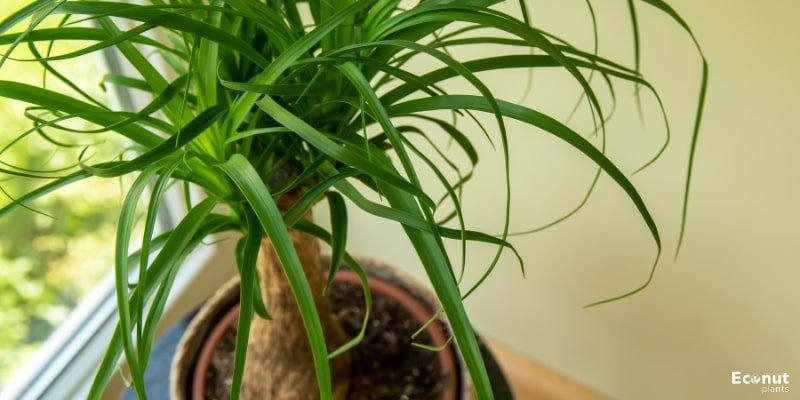
This is the ideal choice if you want a palm that doesn’t grow too big and requires the least amount of upkeep. Its lovely foliage resembles a lively ponytail as it emerges from a bulbous trunk. Though it appears to be a palm, it is a member of the Asparagaceae family and not a true palm.
Because of its strong stem, the ponytail palm can withstand droughts better than other plants. It doesn’t mind being pot-bound and grows well in bright, indirect light. It is an excellent choice for a plant stand display due to its relatively small stature.
2. Sunset Palm

Calyptrocalyx albertisianus is a native of New Guinea that prefers shade and dislikes direct sunlight. It needs lots of spritzing and continually moist soil to stay happy. An indirect-lit, roomy bathroom that is frequently used would be the ideal location for one.
The term “sunset palm” alludes to the vibrant new growth of leaves that begin as bright red and then turn green as they develop. Though you can cut them to make this palm fit inside your bathroom, each of those leaves can grow up to ten feet long outside.
3. Manila Palm

This plant (Veitchia merrillii) is also known as the Christmas palm because its green fruit turns crimson in December. Though it bears a wintery name, this upright-growing tree is extremely sensitive to cold.
Because of their tiny root balls, manila palms are perfect for growing in pots. Trim the flowering branches before the fruit forms if you would rather not deal with its messy yet colourful fruit falling on your floor.
4. Ruffled Fan Palm

This palm (Licuala grandis) has massive, spherical leaves that provide drama, much like a folding fan. Originally from Australia, they can grow up to six feet in height and ten feet in breadth indoors.
In the summer, a ruffled fan palm should only be left outdoors in a secure location due to its massive leaves being susceptible to damage from wind and storms. Although the red, berry-like fruit of this plant is deadly to humans, it seems to be enjoyed by birds and bats.
5. Maya Palm
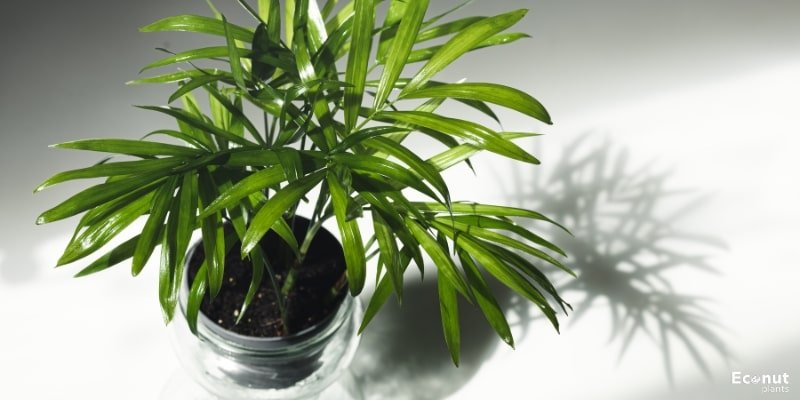
The ideal growing conditions for this palm (Chamaedorea hooperiana) are partial to medium shade, as it doesn’t require much sun. It needs a lot of humidity and water. Its mature height is up to twelve feet.
Fun fact: Before the late 1980s, collectors thought the plant was rare. The Maya’s palm was “rediscovered” in the Veracruz, Mexico, jungle in 1989, and it was given its name in honour of Californian master palm collector Louis Hooper.
6. Mexican Fan Palm
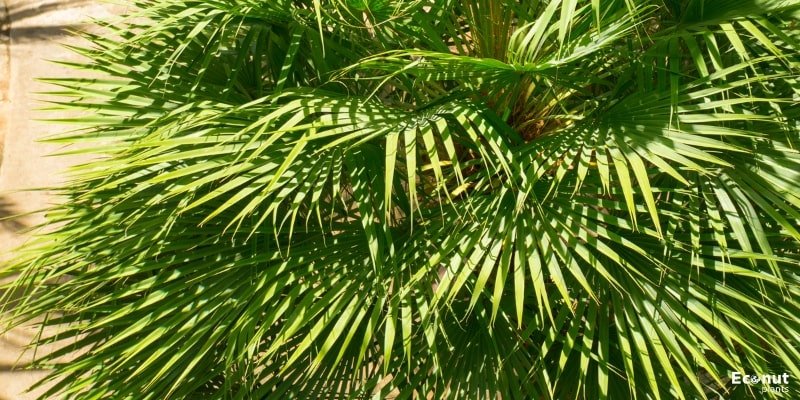
This palm (Washingtonia robusta) is sometimes referred to as the Washington palm, even though there is no true connection between it and the state or the president. In actuality, it is native to the Baja California Peninsula and northwest Mexico. The fan-shaped leaves are the reason it gained its common name.
This hardy plant can tolerate temperatures as low as 18 degrees Fahrenheit! Although it is technically a desert plant and can withstand droughts, it nevertheless needs moderate irrigation to stay healthy.
7. Lady Palm

This (Rhapis excelsa) is about as good of a low-maintenance palm tree as you can get. It merely needs an area with indirect light and an occasional mist; it doesn’t require much trimming or intricate maintenance.
Unlike most palms, the lady palm isn’t truly found “in the wild”; rather, it was deliberately developed in China as an interior plant. With increased shade comes a more vivid contrast between the white stripes on the green leaves of a variegated variety.
8. Banana Palm
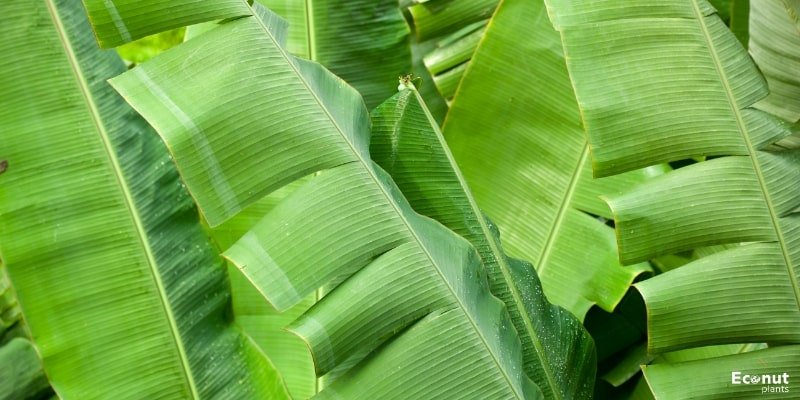
If you can give the banana palm lots of sunlight and moisture, it will make an excellent houseplant. It requires lots of humidity and moist soil, as well as a sunny room in the winter and full sun outside in the summer.
Banana plants can reach a height of 20 feet outdoors. Certain types can grow up to ten feet indoors, although smaller species can fit in better in your area. The dwarf red dwarf reaches six feet, whereas the dwarf cavaldish (Tropicana) develops to nearly eight feet.
You might be let down if you’re hoping to consume bananas that are grown on your property shortly. Not all varieties produce fruit, and when they do, it can take up to 120 days for the banana to reach maturity (from the time the flower forms).
9. Kentia Palm
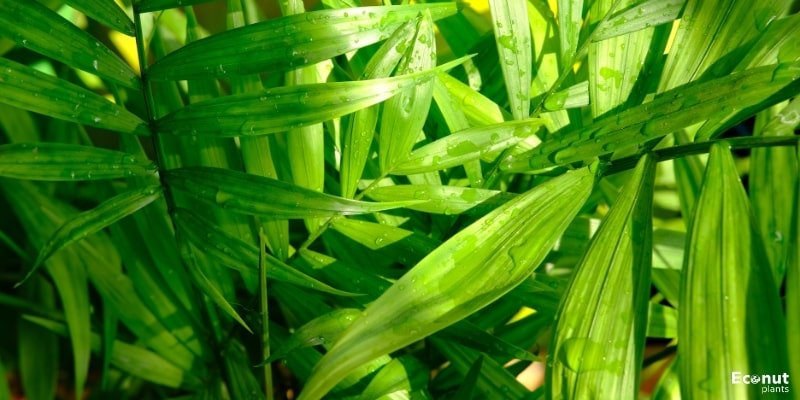
Howea forsteriana, a palm, is the kind of plant you should choose if you want to set it and forget it. It is one of the easiest tropical plants to grow and the least demanding once established; it takes very little care.
The slowly expanding kentia palm can withstand a variety of environmental factors; it won’t outgrow most places and can withstand cold and shade. For a bushy look, it is usually supplied in pots with three or more plants.
10. Sago Palm

Cycas revoluta is a plant native to southern Japan that also mimics palms. It is usually seen with palms in groupings. Its stem resembles an erect pineapple, and its fronds are rigid.
The sago palm grows to a height of three feet at a leisurely pace. It prefers frequent, consistent watering and bright, indirect sunlight, though it may tolerate some shade.
11. Majesty Palm
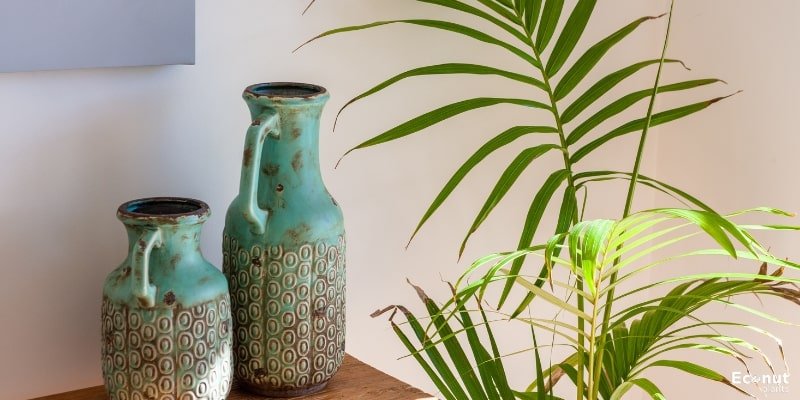
The huge palm, Ravenea rivularis, has airy fronds that arch upward and a slightly enlarged trunk base. This palm, in contrast to other drought-tolerant ones, is indigenous to moist regions of Madagascar and hence prefers its soil to remain moist—not soggy.
Mature Majesty palms grow to a height of 15 feet rather quickly. Although it may tolerate little shadow, it grows best in sunny, indirect light.
12. Chinese Fan Palm
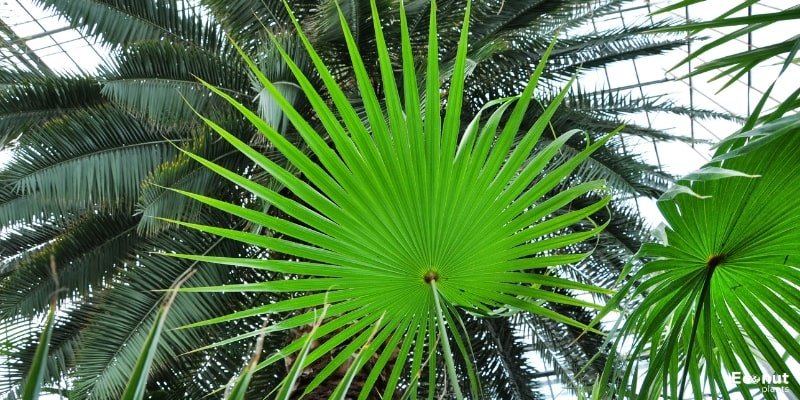
This one also called the fountain palm (Livistona chinensis), has leaves that resemble stars rather than the traditional feathery ones. It can grow in some shade, but it thrives in sunny, indirect light.
The Chinese fan palm, which can reach a height of 15 feet, is a beautiful addition to expansive areas. Look for smaller varieties, including the Taiwan fan palm and dwarf Chinese fan palm, for smaller areas.
13. Pygmy Date Palm
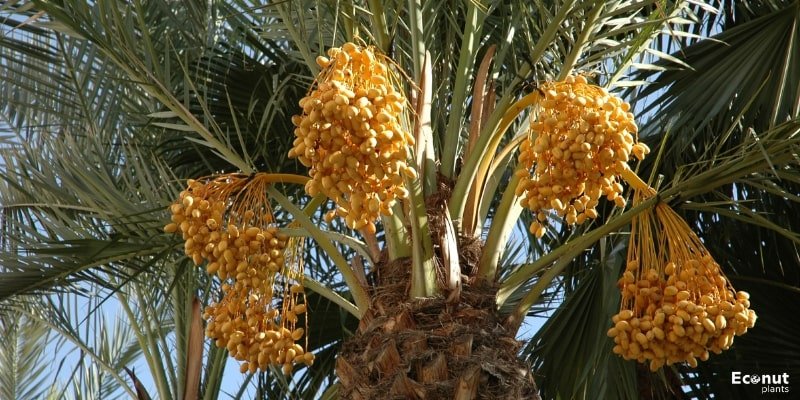
This palm (Phoenix roebelenii) is a tiny species endemic to southern China, unlike its cousins, which may grow up to 75 feet in their natural habitat. The dwarf date palm, pygmy date palm, miniature date palm, robellini palm, and miniature date palm are some more names for this palm of many names.
When grown indoors, pygmy date palms often reach heights of 3 to 5 feet. It has dark green, silvery-green, or glossy, feathery, slender leaves. This drought-tolerant palm can withstand minor frosts in the summer but not a harsh freeze.
14. Areca Palm
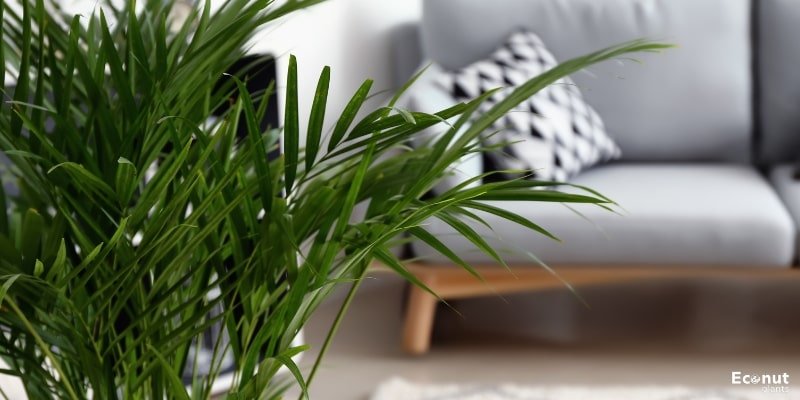
Dypsis lutescens, commonly known as the butterfly or bamboo palm, is a huge palm that makes a beautiful focal point in a large space. These palms are an excellent option for anyone searching for an indoor tree-type plant. They are frequently seen at garden centers and grow to be about 5 feet tall.
If it receives bright, indirect sunlight, the areca palm (pronounced ah-REE-kah) can reach a height of eight feet; otherwise, it can only survive in medium-light environments. Let the soil dry out completely before watering it because it is susceptible to excessive moisture.
15. Parlor Palm
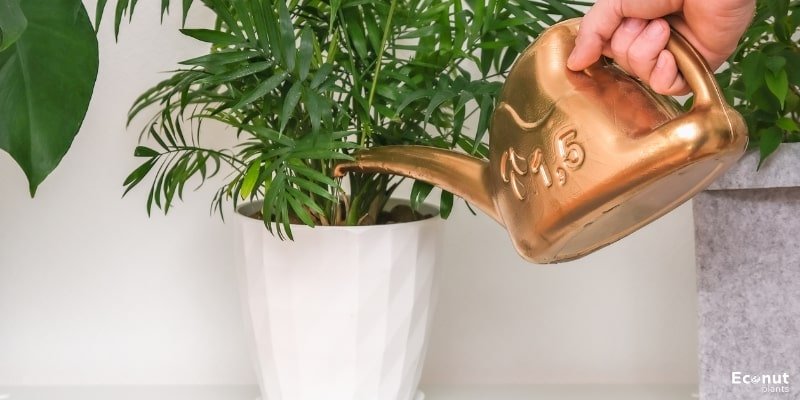
Chamaedorea elegans is a beautiful palm that is well-liked for its dense, clumping growth pattern that mimics a bamboo forest. Possibly the most common indoor palm, it has been cultivated for 50 years as a houseplant.
The parlor palm, which grows slowly and is relatively easy to care for, can reach a height of 12 feet in its natural habitat, but it usually reaches just 2 to 6 feet inside. It can withstand low light levels but grows more slowly as a result.
16. Cascade Palm
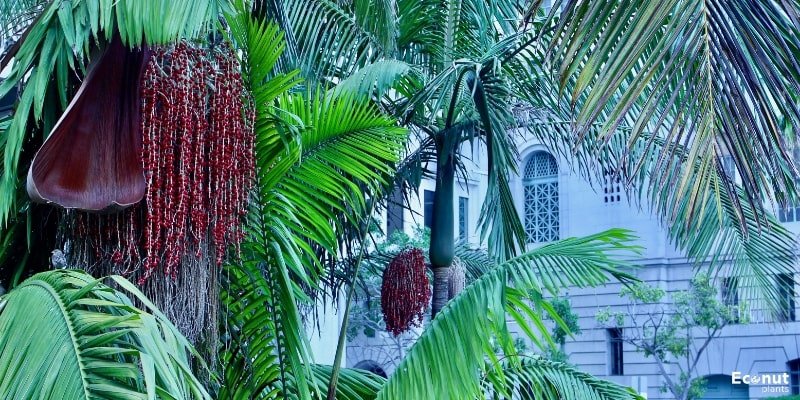
Distinct from palm trees with a central trunk, Chamaedorea cataractarum is a highly full palm with clumps of fronds that may grow as tall as six feet. Mature specimens can be divided into clumps and propagated into new plants.
The cascade palm requires regular watering when cultivated inside because it is native to moist lowlands and streams. Luckily for those who enjoy indoor plants, cascade palms are understory species that can survive with little light.
17. Yucca Palm
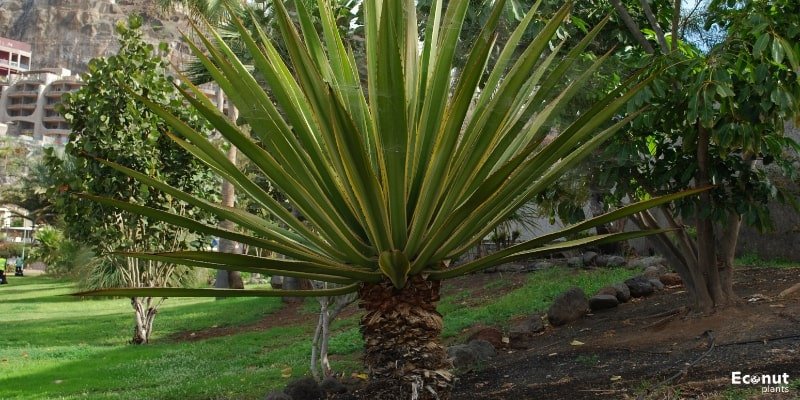
Identification of indoor palm plants is crucial, especially for yucca palms. The spineless yucca palm is called Yucca elephantipes.
The plant does not seem to draw blood like its spiny cousin, even though the tips of its leaves are sharp. Additionally, you may come across the indoor yucca palm marketed as “stick yucca.”
Sturdy, angular green leaves sprout from a visually appealing, rough trunk. The plants may thrive in full sun or partial shade and are highly tolerant of dryness.
18. Fishtail Palm
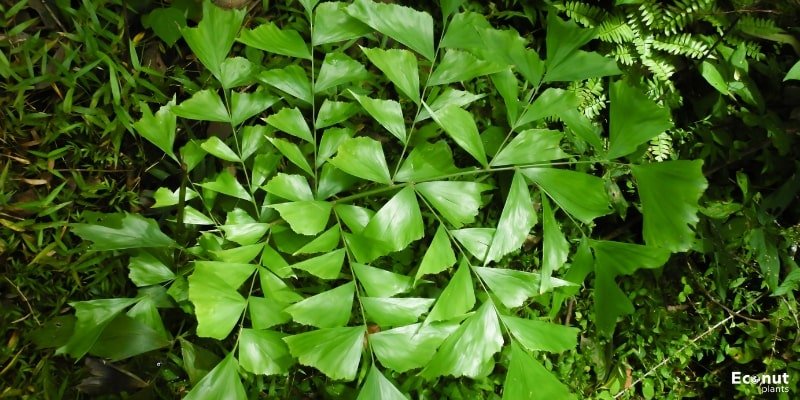
The chopped leaves of fishtail palms resemble fishtails, hence the name. It is harder to maintain these, especially indoors. They need a steady supply of water and an abundance of bright light.
Periodically applying Epsom salts helps address magnesium deficiency when leaves become spotted. Probably all it needs is more sunlight.
Fishtails that develop slowly can be repotted when they are young. Once they reach maturity, repotting becomes unfeasible due to their size and weight, since they can reach up to 20 feet in height. Look out for infestations of mealybugs, aphids, and whiteflies, among other insects.
19. Lipstick Palm
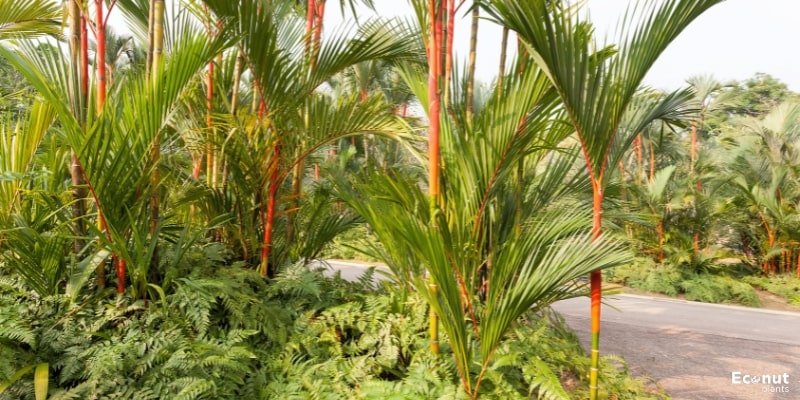
The green trunk of the lipstick palm, ringed in white, rises to a crimson crown shaft, from which the fronds sprout. Black fruit follows white blossoms on healthy plants.
These humidity-loving palms grow up to 35 feet near ponds or rivers in the wild. If the slow-growing plants are well-watered, well-drained, and protected from the sun throughout their early growth, they can make excellent potted plants.
Water the soil twice a year and apply low-salt fertilizer before it dries out entirely. Every few years, it’s crucial to replant these plants in a larger pot to allow their roots to grow out because they may get root-bound.
20. Red Feather Palm

The Red Feather Palm, sometimes called the Flamethrower Palm, produces bright red leaves on its crown shaft. As they mature, the enormous 10–12′ leaves turn green. Beneath the crown shaft are little purple fruits that are enjoyed by birds.
This plant needs frequent watering because it is humidity-sensitive and can only withstand a small amount of drought. Additionally, fertilizing it twice a year might be necessary.
21. Ivory Cane Palm

This palm has a white, or ivory, crown shaft that turns green with age. Although it can grow up to 20 feet in the wild, when housed in containers, it can only reach a more manageable 12 feet.
It produces purple berries after tiny pink blossoms that turn crimson as they ripen. This palm would rather grow in a partially shaded area. If you want to keep it the size it is now, keep it in a little pot. When moving a plant into your yard, give the roots up to 50 feet of space around the base of the plant.
Conclusion
Hopefully, after looking over some of our top picks for indoor palms, you’re not any more perplexed than when you first arrived!
Choose the ideal palm tree for the space where you intend to plant it to give it plenty of room to grow. A wide variety of palm trees can flourish indoors.

